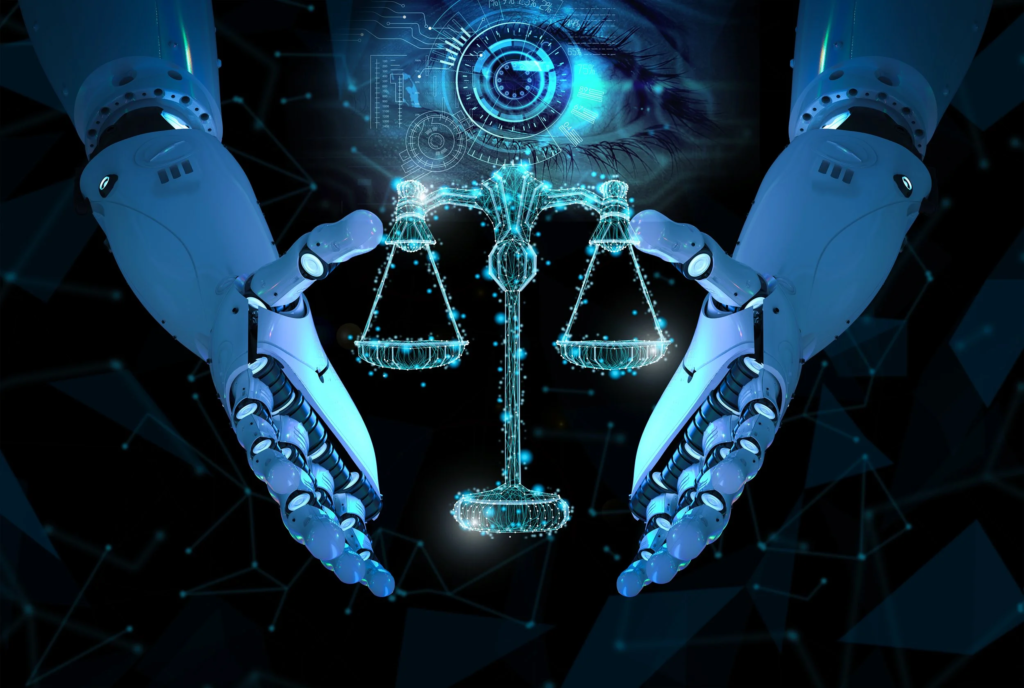
Abstract
Artificial Intelligence (AI) is transforming numerous sectors, and the criminal justice system is no exception. From predictive policing to risk assessment tools and digital evidence analysis, AI technologies are rapidly becoming integrated into law enforcement and judicial processes. While AI promises efficiency and enhanced decision-making, it also raises profound ethical, legal, and societal concerns. This article explores the current status of AI in criminal justice, determine the benefits and challenges of its use, and provides recommendations for responsible implementation to ensure fairness, transparency, and accountability in various fields.
Introduction
The integration of Artificial Intelligence (AI) into the criminal justice system marks a significant evolution in how law enforcement agencies, courts, and correctional institutions operates. With its capacity to analyze vast datasets, identify pattern, and make prediction, AI has the potential to revolutionize policing, court proceedings, and rehabilitation strategies. However, the deployment of AI in criminal justice has sparked intense debates over issue such as bias, transparency, accountability, and civil liberties.
As government and private companies increasingly adopt AI tool for surveillance, risk assessment, and decision support, there is a critical need to evaluate both their efficacy and implications. This research paper examines the role of AI in the criminal Justice system, highlighting its benefits, risks and the ethical frameworks necessary for its responsible use.
Applications of AI in criminal justice
Predictive Policing
Predictive policing uses AI algorithms to analyze crime data and predict where crimes are likely to occur. Systems like Predictive Policing process historical crime data, time patterns, and geographical information to allocate police resources more effectively.
These tool aim to prevent crime proactively by directing officers to potential hotspots. While this can enhance efficiency, concerns arise over data accuracy and the reinforcement of existing biases, especially in minority neighborhoods.
Facial Recognition Technology AI-powered facial recognition systems are increasingly used to identify suspects, monitor public areas, and verify identities. These technologies are employed in airports, public transports systems, and police databases to match individuals against known offenders.
While effective in some cases, facial recognition has been criticized for inaccuracies- particularly regarding people of color-and for potential infringements on privacy rights.
Risk Assessment and Sentensing
AI-based risk assessment tools like COMPAS (Correctional Offender Management Profiling for Alternative Sanctions) help judges determine the likelihood of a defendant reoffending. These tools are used during bail hearing, sentencing, and parole decision.
Although these systems aim to promote objectivity, studies have shown that some algorithms may exhibit racial bias, leading to disproportionately harsh outcomes for marginalized communities.
Digital Evidence Analysis AI aids in processing digital evidence such as text messages, email, videos, and social media posts. Natural language processing and machine learning techniques can shift through massive volumes of digital content to identify relevant information for investigations.
This enhances the speed and accuracy of digital forensics but raises concerns about data privacy especially when AI tools analyze information from individuals not suspected of a crime.

Benefits of AI in Criminal Justice
Improved Efficiency and Resource Allocation
AI technologies can process and analyze data far more rapidly than humans, enabling law enforcement agencies to allocate resources more effectively. Predictive tools help deploy patrols strategically while AI-powered databases streamline investigations and case management.
Enhanced Decision-Making
AI can provide evidence-based risk assessments, potentially reducing the influence of human biases and subjective judgements. Judges and parole boards can use AI tools to make more informed decisions about sentencing and release.
Crime Prevention
By identifying patterns and predicting criminal activity, AI tools can help prevent crime before it occurs. Early interventions may disrupt criminal trajectories and reduce recidivism.
Support for investigative work
Artificial intelligence has proven to be a valuable tool in enhancing the efficiency, accuracy, and scope of investigative work in criminal justice. Law enforcement agencies are increasingly relying on AI-powered tool for analysing large database, identifying patterns, and generating leads that would be difficult or impossible to detect through traditional methods. These capabilities extend beyond simple data processing and include advanced functions such as facial recognition, predictive modeling, and natural language processing.
AI in Judicial Decision-Making
One of the most debated application of artificial intelligence in the criminal justice system is its use in judicial decision-making. Court in some jurisdiction have adopted AI-assisted tools to support judges in making decisions regarding bail, sentencing, and parole eligibility. These tools aim to bring greater consistency, objectivity, and efficiency to legal decisions.
A well-known example is the Correctional Offender Management Profiling for Alternative Sanctions (COMPAS), a risk assessment tool used in several U.S. states. COMPAS analyzes a defendant’s prior criminal history, personal background, and behavioral indicators to assign a risk score predicting the likelihood of recidivism. Judges may use this information to guide decisions on pretrial detention or sentencing lengths.
Proponents argue that AI tools can help reduce human biases and disparities that often plague judicial decisions. Human judges may unintentionally be influenced by factors such as race, gender, or appearance, while AI relies purely on data driven insights.
However, critics raise serious concerns about algorithmic bias and lack of transparency. Studies have shown that some AI tools, including COMPAS, may perpetuate or even exacerbate existing racial disparities due to biased training data. If historical data reflects systemic discrimination, the AI will likely mirror those inequities. Furthermore, many proprietary tools operate as “black boxes,” where neither the public nor legal professionals can fully scrutinize the logic behind their decisions, raising due process concerns.
Ultimately, the integration of AI in judicial decision-making must strike a careful balance between leveraging technology for efficiency and ensuring the preservation of fairness, transparency, and accountability in the justice process.
Enhancing Correctional System Management
AI is also making inroads into the correctional system, with applications aimed at improving inmate management, reducing recidivism, and optimizing rehabilitation programs. By analyzing data on inmate behavior, psychological evaluations, and prior offenses, AI can help correctional institutions assess risks, design tailored intervention plans, and allocate resources more effectively.
For instance, some prison systems use predictive analytics to evaluate which inmates are most likely to engage in violent behavior or attempt escape, allowing for targeted monitoring and intervention. AI models can detect early signs of distress, radicalization, or deteriorating mental health among inmates by analyzing communication patterns, social networks within the facility, or incident reports. This proactive approach can lead to better prevention of violence and self-harm.
Another key application is in recidivism prediction and rehabilitation planning. AI tools can help identify which individuals are most at risk of reoffending after release, enabling more intensive post-release supervision and support services. Simultaneously, these tools can match inmates with programs most likely to be effective for their specific needs—such as anger management, substance abuse treatment, or vocational training—based on predictive models.
AI also plays a role in automating administrative tasks within correctional facilities, such as scheduling, resource allocation, and tracking inmate movements. This not only enhances operational efficiency but also allows correctional staff to focus more on direct engagement with inmates and rehabilitation efforts.
Despite its potential benefits, deploying AI in correctional settings raises ethical questions about privacy, autonomy, and potential stigmatization. Inmates may feel constantly surveilled, and risk scores might influence how they are treated or the opportunities available to them within the facility. Ensuring that AI usage in corrections adheres to ethical standards, protects individual rights, and includes mechanisms for appeal or review is essential to avoid reinforcing punitive approaches at the expense of rehabilitation.

Ethical Considerations and Bias in AI Systems
Perhaps the most critical challenge in deploying AI across the criminal justice system is addressing the ethical and social implications, particularly regarding bias, accountability, and transparency. AI systems are only as good as the data they are trained on, and if that data is flawed, biased, or incomplete, the resulting decisions will reflect and potentially amplify those issues
One of the most well-documented issues is racial bias in predictive algorithms. Because these systems often rely on historical crime data—collected during periods of over-policing or discriminatory practices—they may encode and perpetuate racial disparities. For example, if minority neighborhoods were historically subject to more frequent policing, AI may wrongly identify those areas as higher-risk, regardless of current crime rates. This can lead to a self-fulfilling cycle of increased surveillance and arrest rates in already marginalized communities.
Another ethical concern is the opacity of algorithmic decision-making. In many cases, AI systems used in criminal justice are proprietary and not subject to public scrutiny. This lack of transparency undermines the right of defendants to understand and challenge the basis of decisions affecting their liberty, such as bail denial or parole refusal. Calls for explainable AI and the use of open-source, peer-reviewed algorithms are growing in response to these concerns.
There is also a risk of automation bias, where human decision-makers overly defer to AI outputs, even in the face of contradictory evidence or intuition. This is particularly dangerous in high-stakes environments like courts, where errors can lead to unjust imprisonment or wrongful release.
To address these challenges, experts and advocates recommend a framework of ethical AI governance, including:
- Independent algorithmic audit
- Transparency mandates and documentation of decision logic
- Public input and stakeholder engagement in AI system design
- Regular evaluation for discriminatory impact
- Mechanisms for appeal and human oversight
- Implementing these principles is crucial to ensure that AI supports justice rather than undermines it.
The Future of AI in Criminal Justice
Looking ahead, the integration of AI into the criminal justice system is likely to deepen, with continued advances in machine learning, data analytics, and automation. Emerging applications include behavioral analysis through wearable technology, AI-driven legal research tools, and real-time risk assessment in dynamic environments such as active crime scenes
Legal tech companies are developing AI tools to assist prosecutors, defense attorneys, and judges with case law analysis, evidence synthesis, and argument generation. These tools promise to enhance the quality and efficiency of legal proceedings by reducing the time and cost associated with legal research.
Meanwhile, developments in emotion recognition and psychological profiling may be used to assess witness credibility, detect deception, or inform jury selection—though these applications remain controversial and require robust validation before widespread use.
The incorporation of blockchain and AI may also lead to innovations in evidence management, ensuring the integrity and traceability of digital evidence through tamper-proof systems.
However, the trajectory of AI in criminal justice will depend heavily on regulatory frameworks, public trust, and the willingness of institutions to confront ethical dilemmas head-on. Without proper checks and balances, the misuse or overreliance on AI could lead to injustices that undermine the legitimacy of the entire justice system.
Thus, a human-centered approach to AI—where technology serves as an aid rather than a replacement for ethical judgment—must guide future developments. Collaboration among technologists, legal experts, ethicists, and affected communities will be key to shaping an equitable and effective future.
Conclusion
AI holds transformative potential for the criminal justice system, offering powerful tools to enhance investigations, support judicial decision-making, manage correctional facilities, and reduce crime through predictive analytics. However, these benefits come with significant risks—particularly in terms of bias, accountability, transparency, and ethical use.
The challenge lies not in whether to use AI in criminal justice, but how to use it responsibly. Ensuring that AI systems uphold the principles of fairness, human rights, and due process is essential for maintaining public trust and delivering true justice. As technology evolves, so must the legal and ethical frameworks that govern it. Ultimately, the future of AI in the criminal justice system will depend on integrating innovation with integrity—balancing technological capabilities with unwavering commitments to human dignity, legal fairness, and social equity.
References
- https://www.techuk.org/resource/ai-adoption-in-criminal-justice
- https://cloudtweaks.com/2024/09/ethics-ai-criminal-justice-system/
- Angwin, J., Larson, J., Mattu, S., & Kirchner, L. (2016). Machine Bias: There’s software used across the country to predict future criminals. And it’s biased against blacks. ProPublica.
- https://www.propublica.org/article/machine-bias-risk-assessments-in-criminal-sentencing
- Government of India, Ministry of Home Affairs. (2020). Crime and Criminal Tracking Network & Systems (CCTNS).
- https://digitalpolice.gov.in/




